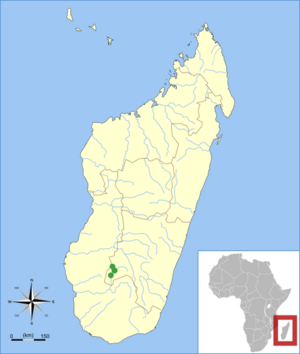Isalo serotine facts for kids
Quick facts for kids Isalo serotine |
|
|---|---|
| Conservation status | |
| Scientific classification | |
| Genus: |
Laephotis
|
| Species: |
malagasyensis
|
 |
|
| Collection localities of Laephotis malagasyensis | |
| Synonyms | |
|
|
The Isalo serotine (Laephotis malagasyensis) is a vesper bat of Madagascar in the genus Laephotis. It is known only from the vicinity of the Isalo National Park in the southwestern part of the island, where it has been caught in riverine habitats. After the first specimen was caught in 1967, it was described as a subspecies of Eptesicus somalicus (now Neoromicia somalica) in 1995. After four more specimens were collected in 2002 and 2003, it was recognized as a separate species. Because of its small distribution and the threat of habitat destruction, it is considered "vulnerable" in the IUCN Red List.
Laephotis malagasyensis is a relatively small species, with a forearm length of 30 to 32 mm (1.2 to 1.3 in) and a body mass of 3.9 to 9 g (0.1 to 0.3 oz). The fur is dark brown above and mixed buff and gray below. The ears are translucent and the tibia is short. The duration of the echolocation call, which consists of a component with rapidly falling frequency and one showing more stable frequency, averages 4.9 ms and the interval between calls averages 69.1 ms.
Description
| Specimen | Sex | Forearm | Tail | Hindfoot | Ear | Mass |
|---|---|---|---|---|---|---|
| ROM 42713 | Female | 32 | 27 | 6 | 12 | 9 |
| FMNH 175988 | Male | 30 | 37 | 4 | 11 | 3.9 |
| FMNH 175989 | Female | 32 | 35 | 5 | 12 | 6.0 |
| UA, uncatalogued | Male | 30.1 | 30.4 | 5.3 | 9.8 | – |
| UA, uncatalogued | Female | 32.0 | 29.3 | 6.9 | 11.4 | – |
| All measurements are in millimeters, except mass in grams. | ||||||
Laephotis malagasyensis is a relatively small "pipistrelle", but larger than Neoromicia somalica. The fur on the back is long and dark brown and the underparts contain both gray and dark buff hairs; there, the fur becomes lighter towards the tail. The fur is darker than in N. somalica, but paler than in L. matroka. The brown ears are translucent. The tragus (a projection on the inner side of the outer ear) is similar to that of N. somalica, but may be a little narrower. Relative to the two other Malagasy Laephotis species, the tibia is short.
The skull is somewhat smaller than that of L. matroka and the braincase and palate are narrower. Compared to N. somalica, the skull is broader. The ridge on the lacrimal bone is better developed, the palate is broader, the frontal bones contain a depression and are swollen at the sides, the mastoid bones are smaller, and the coronoid and angular processes of the mandible (lower jaw) are more prominent.
The echolocation call of this species was reported in a 2007 study that consists of a component with rapidly falling frequency followed by one with more slowly changing frequency. The call takes 3.6 to 6.3 ms, averaging 4.9 ms, and the period between two calls is 34.2 to 94.4 ms, averaging 69.1 ms. The maximum frequency averages 79.8 kHz, the minimum frequency averages 40.5 kHz, and the call emits the most energy at a frequency of 45.7 kHz.
Distribution and ecology
Laephotis malagasyensis is known only from the vicinity of Isalo National Park, an area of about 2000 km2 (800 sq mi), in interior southwestern Madagascar. The holotype was caught in 1967 in a mistnet set in a row of palms along a river in dry savannah habitat. Peterson and colleagues reported that it had been collected near the village of Marinday, but Goodman and Ranivo suggested that it may instead have come from near Ilakaka. Two specimens, a male and a female, were collected at different localities in Isalo National Park in early December 2002, both in mistnets near rivers. Two others followed in 2003, also from the national park, and caught in woodland near rivers. A 2009 study on echolocation described the call of six individuals of L. malagasyensis from an unspecified site within the national park. In view of its small known range and the threat of habitat destruction, the IUCN Red List assesses the species as "vulnerable"; further research is recommended on its roosting and dietary habits.


